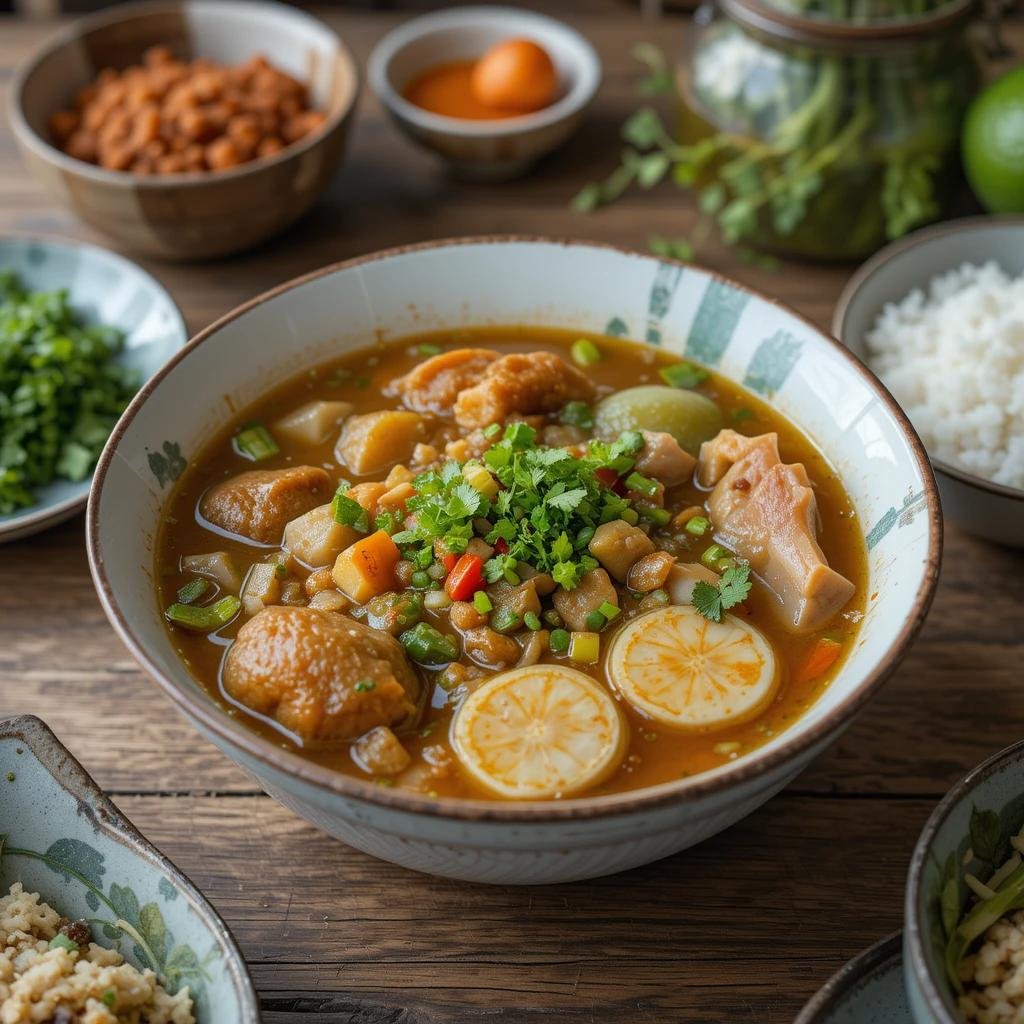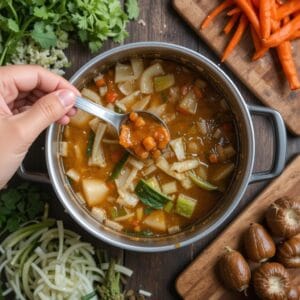Table of Contents
When you think of a hearty, comforting dish from the Philippines, sinigang is often at the top of the list. This iconic soup is loved for its distinct sourness, making it the ultimate treat on a rainy day or when you’re craving something deeply flavorful. But have you ever wondered how to make sinigang more sour to suit your taste buds perfectly? Let’s dive into the art and science behind crafting the perfect tangy sinigang.
Understanding Sinigang: A Flavorful Filipino Dish
Sinigang is more than just a dish—it’s a cultural treasure. Known for its savory yet sour profile, this soup often includes a variety of meats, seafood, or vegetables. The magic lies in the tangy broth that brings everything together. It’s a dish that invites creativity, with each household having its own twist.
“Sinigang is a reflection of Filipino hospitality—warm, vibrant, and full of unique flavors.”
At its core, sinigang represents balance. While the sourness is its star feature, it harmonizes beautifully with the saltiness of the broth, the freshness of the vegetables, and the umami from the meat or seafood.
Popular Variations of Sinigang and Their Flavor Profiles
Sinigang na Bangus: Milkfish Sinigang
Sinigang na bangus, or milkfish sinigang, is a beloved alternative for those who prefer a lighter, healthier option. Bangus, the national fish of the Philippines, has a delicate flavor and tender texture that pairs beautifully with the tangy broth. Its slightly sweet, mild taste allows the sourness to truly shine without being overpowering.
If you’re looking to make sinigang na bangus more sour, tamarind remains a classic choice. However, the use of kamias or green mangoes can elevate the dish, adding a fruity tang that complements the fish’s subtle flavor. Adding these ingredients early in the cooking process allows their sourness to infuse fully into the broth, creating a balanced yet pronounced tang.
Pro Tip: Serve sinigang na bangus with a side of calamansi or lemon slices so each diner can adjust the sourness to their liking. It’s a simple yet effective way to personalize the dish!
Sinigang na Hipon: Shrimp Sinigang
Seafood lovers adore sinigang na hipon, where succulent shrimp takes center stage. Adding sour fruits like kamias or green mangoes can elevate the tanginess while complementing the delicate flavor of the shrimp.
Sinigang sa Miso: A Unique Take on the Dish
For a twist, some people opt for sinigang sa miso, which incorporates fermented soybean paste. This variation adds depth and complexity to the broth, and the sourness can still shine through with ingredients like tamarind or lemon.
The Science of Sourness in Sinigang
Sourness isn’t just a taste—it’s a sensation that wakes up your palate and makes every bite exciting. But what makes a dish sour? It’s all about acids. Ingredients like tamarind, kamias, and vinegar contain natural acids that trigger the sour receptors on your tongue.
Natural Acids and Their Impact on Taste
Tamarind is a classic choice because it provides a well-rounded sourness that feels natural and not harsh. Other fruits like green mangoes and kamias are rich in citric acid, delivering a sharp tang that can brighten the broth instantly.
Enhancing Sourness Without Overpowering Other Flavors
The key to enhancing sourness is balance. You don’t want your sinigang to taste like pure vinegar, right? By layering different sour ingredients, you can achieve complexity without overwhelming the dish. Think of it as adding a squeeze of lemon to a salad dressing—it’s subtle but impactful.
“Sourness should enhance the dish, not overshadow the other wonderful flavors in your sinigang.”
Traditional Ways to Make Sinigang More Sour
Using Tamarind: The Classic Choice
Tamarind pulp or paste is the most traditional way to add sourness to sinigang. To use it, you can boil tamarind pods in water and strain the juice into your soup. Tamarind paste or powder is also an excellent option for convenience.
Pro Tip: If you want a stronger tang, use freshly harvested tamarind pods—they pack a punch.
Adding Kamias: A Tangy Alternative
Kamias, also known as bilimbi, is a local fruit often used to make sinigang sour. Its high acidity gives a clean, sharp tang that’s perfect for seafood-based sinigang. Simply slice the kamias and let it simmer in the broth until it releases its flavor.
Green Mangoes and Their Distinct Sourness
Unripe green mangoes offer a fruity sourness that’s less traditional but equally delicious. They’re best for sinigang with lighter proteins like shrimp or fish. Just peel, chop, and toss them into the pot for a unique twist.
Modern Approaches to Amplifying Sourness
Not everyone has access to tamarind or kamias, especially if you’re making sinigang outside the Philippines. But don’t worry—modern techniques can save the day.
Using Citric Acid or Lemon Juice
Citric acid is a handy pantry ingredient that can mimic the tanginess of tamarind. Start with a small pinch and adjust to taste. Similarly, lemon juice is a great alternative that’s easily available and offers a fresh sourness.
Incorporating Vinegar for a Balanced Tang
While vinegar isn’t traditional, it can work in a pinch. Go for mild types like cane or apple cider vinegar to avoid overpowering the soup. Just a splash can elevate the tanginess without making it too sharp.
Common Mistakes When Adjusting Sourness in Sinigang
While tweaking the sourness in sinigang seems straightforward, there are some common pitfalls to avoid. A little too much of one ingredient or a mismatch in flavors can quickly throw the dish off balance. Let’s tackle these common errors to ensure your sinigang remains delicious and well-rounded.
Overusing Ingredients: Striking the Right Balance
It’s easy to go overboard when adding sour components like tamarind or vinegar. Remember, sourness is a supporting character in the flavor symphony, not the lead vocalist screaming at the top of their lungs. A good rule of thumb is to add your sour ingredient gradually. Taste the broth after each addition, and stop when the flavor feels just right.
Pro Tip: If you accidentally make the broth too sour, balance it out by adding more water, a touch of sugar, or extra meat and vegetables to neutralize the acidity.
Choosing the Wrong Sour Component
Not all sour ingredients work equally well with all types of sinigang. For example, tamarind’s earthy tang pairs beautifully with bangus, but its depth might overpower delicate shrimp in sinigang na hipon. Conversely, green mangoes might lack the richness needed for heavier broths. Consider the protein and overall profile of your dish when selecting your sour agent.
“The wrong sour ingredient is like wearing mismatched shoes—it’ll still work, but it won’t feel quite right.”
Expert Tips for Perfectly Sour Sinigang
Making sinigang more sour isn’t just about dumping ingredients into a pot—it’s about crafting a dish that feels balanced and satisfying. Here are some expert-approved tips to help you elevate your sinigang game.

Adjusting to Personal Preferences
Sinigang is incredibly versatile, and one person’s “perfectly sour” might be too mild or too intense for someone else. The key is to customize the sourness based on who’s eating. Cooking for yourself? Trust your palate. Serving a crowd? Go for a moderate level of tang and provide additional sour components on the side, like calamansi or tamarind paste, for those who want to adjust their bowl.
Combining Ingredients for a Complex Sourness
Why settle for just one source of sourness? Layering different ingredients can create a more nuanced and interesting flavor. For example, you could combine tamarind with a splash of lemon juice for brightness or use kamias and green mangoes together for a fruity, tangy punch.
“Think of your sour ingredients as paint on a palette—mixing them creates a masterpiece.”
🍋 + 🌱 + 🍖 = A tangy bowl of perfection!
How to Save a Sinigang That’s Not Sour Enough
Sometimes, despite your best efforts, the sourness just isn’t there. But don’t panic—you can rescue your sinigang and give it the tangy punch it deserves with a few clever tricks.
Quick Fixes for a Bland Sinigang
If your sinigang falls flat, here are some quick fixes:
- Add tamarind concentrate or paste: These are highly concentrated and can bring instant sourness.
- Throw in sour fruits: Kamias or green mango slices work wonders in a pinch.
- Try citric acid: Just a tiny pinch will amp up the sourness immediately.
What to Do If It’s Too Sour
On the flip side, if you’ve gone a little too far with the sour ingredients, don’t fret. Here’s how to fix it:
- Dilute with broth or water: Adding more liquid is the simplest way to tone down the acidity.
- Introduce sweetness: A small amount of sugar or even grated carrots can help balance the flavor.
- Increase the other elements: Add more protein, vegetables, or even a bit of salt to round out the taste.
“Cooking is all about balance—when one flavor tips the scale, another can bring it back into harmony.”
FAQs
Can You Make Sinigang More Sour After Cooking?
Yes, you can! If the soup needs more tang after it’s done cooking, simply stir in a concentrated sour agent like tamarind paste, lemon juice, or vinegar. Make sure to add it slowly and taste as you go.
What is the Best Ingredient for a Very Sour Sinigang?
The best ingredient depends on your preference. Tamarind is the most traditional and versatile, but kamias and green mangoes offer unique flavors. For a modern twist, citric acid or lemon juice works well too.
How Do You Avoid Overpowering the Other Flavors?
Add sour components gradually and taste frequently. Balance the sourness with the saltiness of fish sauce and the richness of your protein.
Conclusion: Achieving the Perfect Sourness in Sinigang
Sinigang is a culinary masterpiece that brings people together, and its sourness is what gives it that extra spark. Whether you’re aiming for a subtle tang or an intense punch, making sinigang more sour is all about balance, creativity, and understanding your ingredients.
When you’re preparing sinigang, think of it as a journey. Each addition of tamarind, kamias, or green mango transforms the dish and brings you closer to your personal version of perfection. Traditional methods remain the gold standard, but modern approaches offer exciting alternatives, especially for those who don’t have access to native ingredients.
You might also like What is Sinigang Seasoning?





